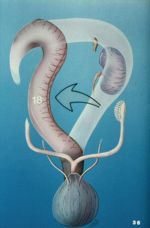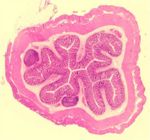Difference between revisions of "Colon - Anatomy & Physiology"
Jump to navigation
Jump to search
| Line 32: | Line 32: | ||
'''Microbial Fermentation''' | '''Microbial Fermentation''' | ||
*''Mass movements'' move the content of the large intestine on to the [[Rectum - Anatomy & Physiology|rectum]]. | *''Mass movements'' move the content of the large intestine on to the [[Rectum - Anatomy & Physiology|rectum]]. | ||
| − | |||
| − | |||
| − | |||
| − | |||
| − | |||
| − | |||
| − | |||
| − | |||
==Histology== | ==Histology== | ||
Revision as of 08:30, 17 July 2008
Introduction
The colon is a site of microbial fermentation which produces VFAs. These are then absorbed in the colon. The colon can be divided into the following portions:
- Ascending
- Transverse
- Descending
Structure
The following anatomical arrangement is found only in cats and dogs, see species differences.
- The ascending colon continues from the iluem at the ileocolic junction.
- It runs to the right of the cranial mesenteric artery in a caudal to cranial direction.
- At the cranial border of the mesentry it turns medially to become the transverse colon.
- The transverse colon runs from the right side of the abdomen to the left side of the abdomen.
- Cranial to the transverse colon is the stomach, and caudal to it is the small intestine and cranial mesenteric artery.
- The descending colon continues on from the transverse colon running caudally on the left from the level of (???).
- It then passes more medially as it enters the pelvic cavity
- Upon entering the pelvic cavity it is continued as the rectum.
Function
Transportation
- Motility in most species is brought about by segmentation and peristalsis.
- Antiperistalsis also occurs and is particularly important in horses, ruminants and rodents.
- Chyme is transported towards the small intestine so as to fill the caecum.
- In the horse the antiperistaltic movements delay the movement of chyme from the ventral to the dorsal colon, which increases the time chyme is available for fermentation in the ventral colon.
Absorption Microbial Fermentation
- Mass movements move the content of the large intestine on to the rectum.
Histology
- Mucosa has a columnar epithelium.
- Mucosa is thick.
- Mucosa has long glands.
- Submucosa has large lymphatic nodules which may interrupt the lamina muscularis.
- Lamina muscularis is incomplete.
Species Differences
Ruminant
- The ascending colon is the longest part of the colon and is composed of three parts:
- Ansa proximalis
- Has a sigmoid flexure that passes around the caudal border of the mesentry to the left side of the root of the mesentry.
- Ansa spiralis
- Consists of two centripetal turns and two centrifugal turns in the ox.
- There are three turns in the sheep and four in the goat.
- In the ox, the ansa spiralis is a flat disc, whilst in the small ruminants it takes the form of a cone.
- Consists of two centripetal turns and two centrifugal turns in the ox.
- Ansa distalis
- Goes back around the caudal border of the mesentry, to the right side of the root of mesentry.
- It then passes cranially adjacent to the mesentry until it reaches the cranial border of the mesentry.
- Ansa proximalis
- The transverse colon crosses the midline of the abdomen, from right to left at the cranial border of the mesentry.
- The descending colon continues caudally to the rectum and anus.
- It has a sigmoid flexure before it enters the pelvic cavity.
- Development
- The ox's ascending colon expands caudally around the root of the mesentry on the left side of the mesentry (compare to horse, where it expands cranially).
Horse
Pig
- The arrangement of the transverse and descending colon is similar to that of the dog and cat, but the ascending colon is different.
- The ascending colon is elongated and coiled to form a cone-shaped organ.
- The base of the cone is attached to the dorsal abdominal wall and the apex points ventrally.
- The position of the ascending colon varies with filling of the stomach.
- From the caecum, there are clockwise centripetal turns to the apex of the cone.
- Then the centrifugal turns run anti-clockwise on the inside of the cone.
- Centripetal turns have two taenia, whilst centrifugal turns have none.

